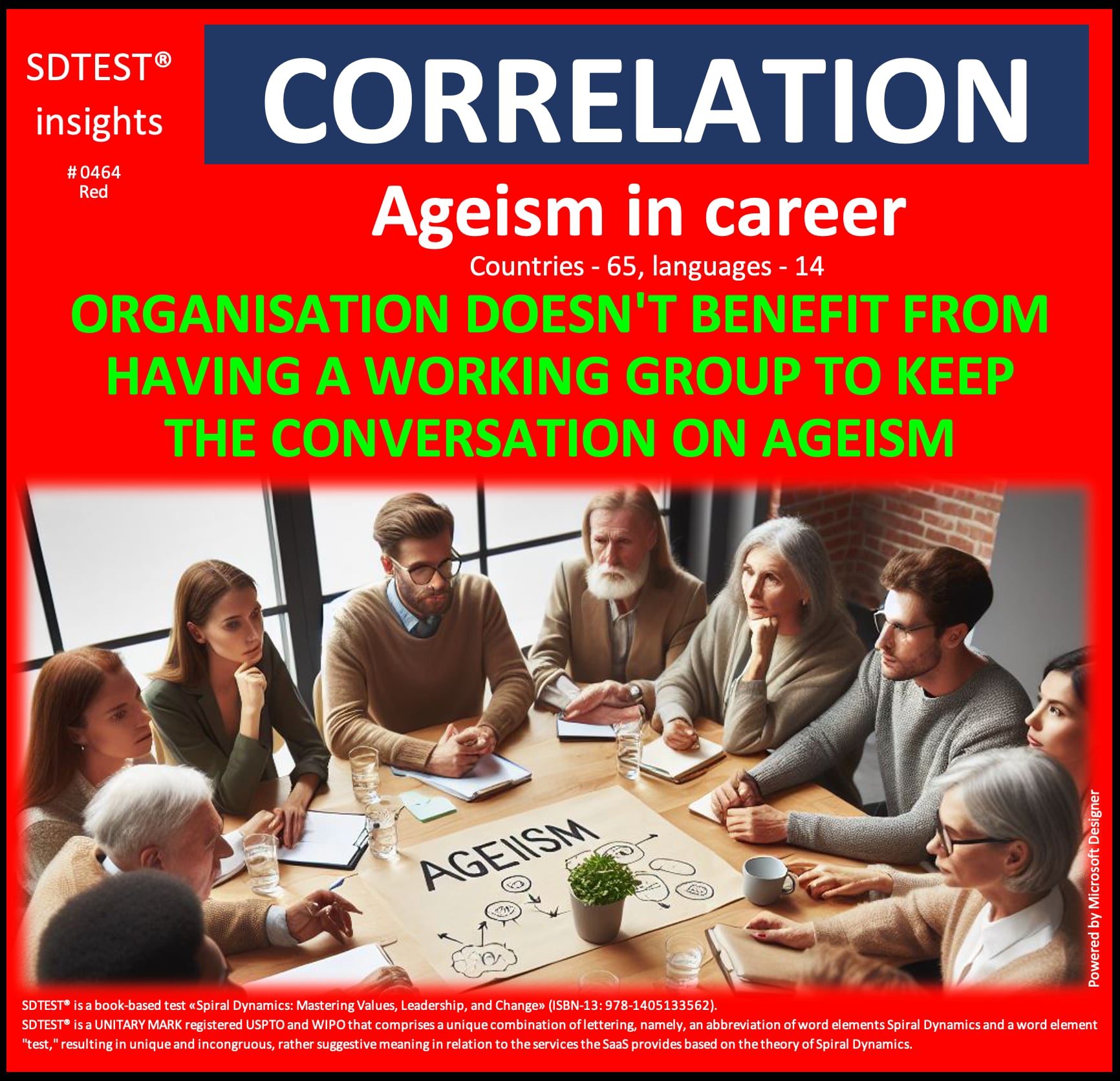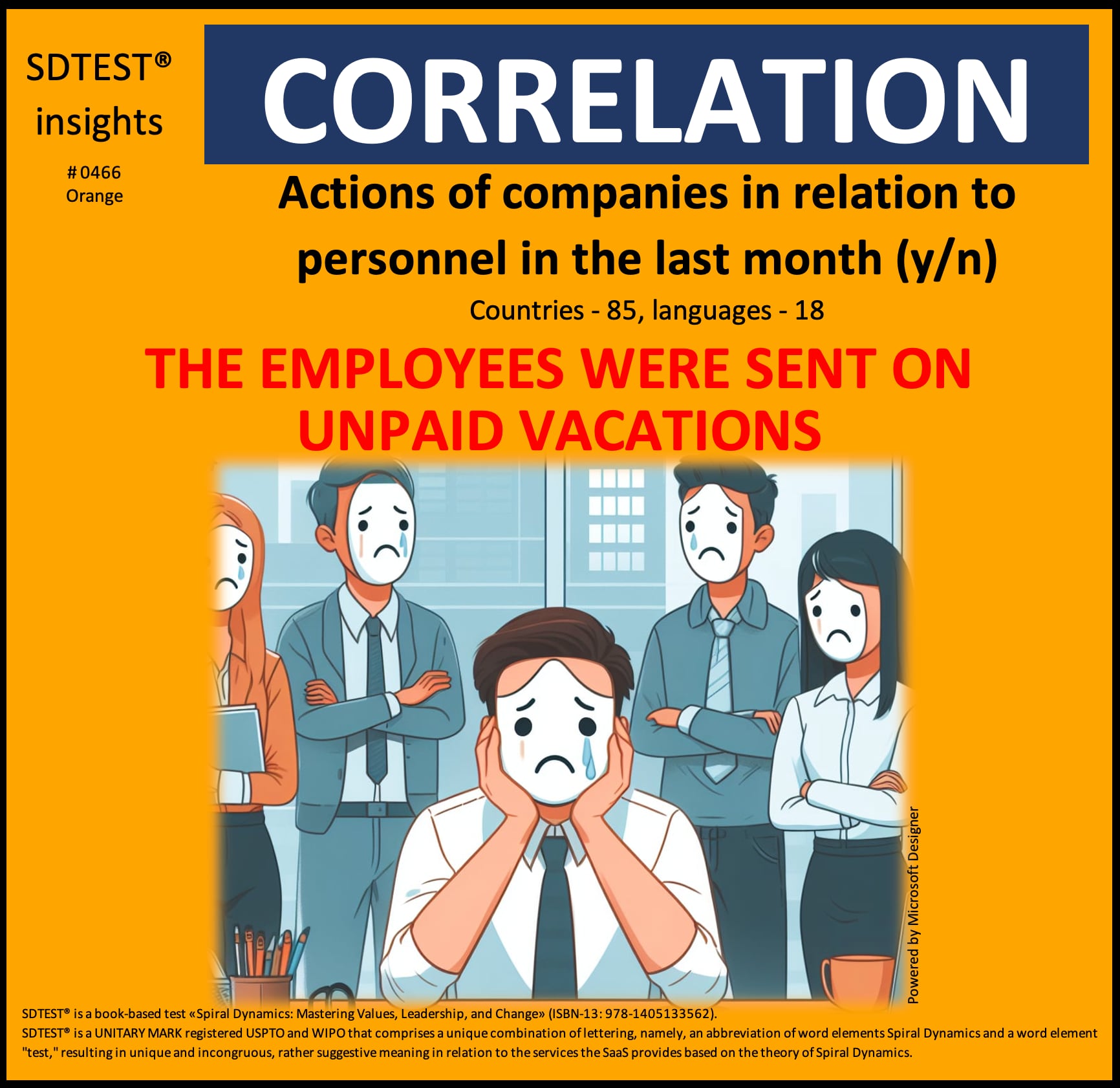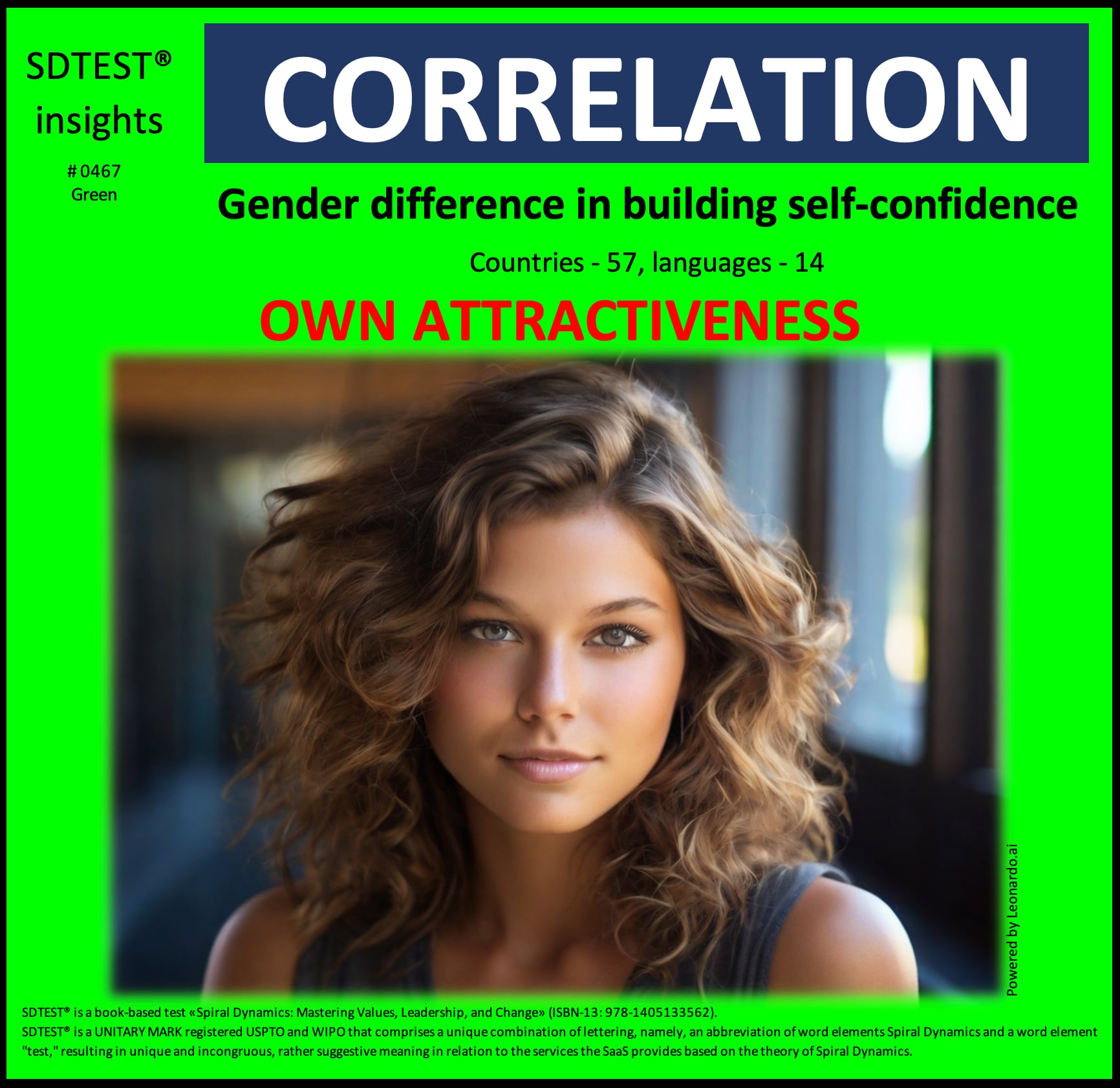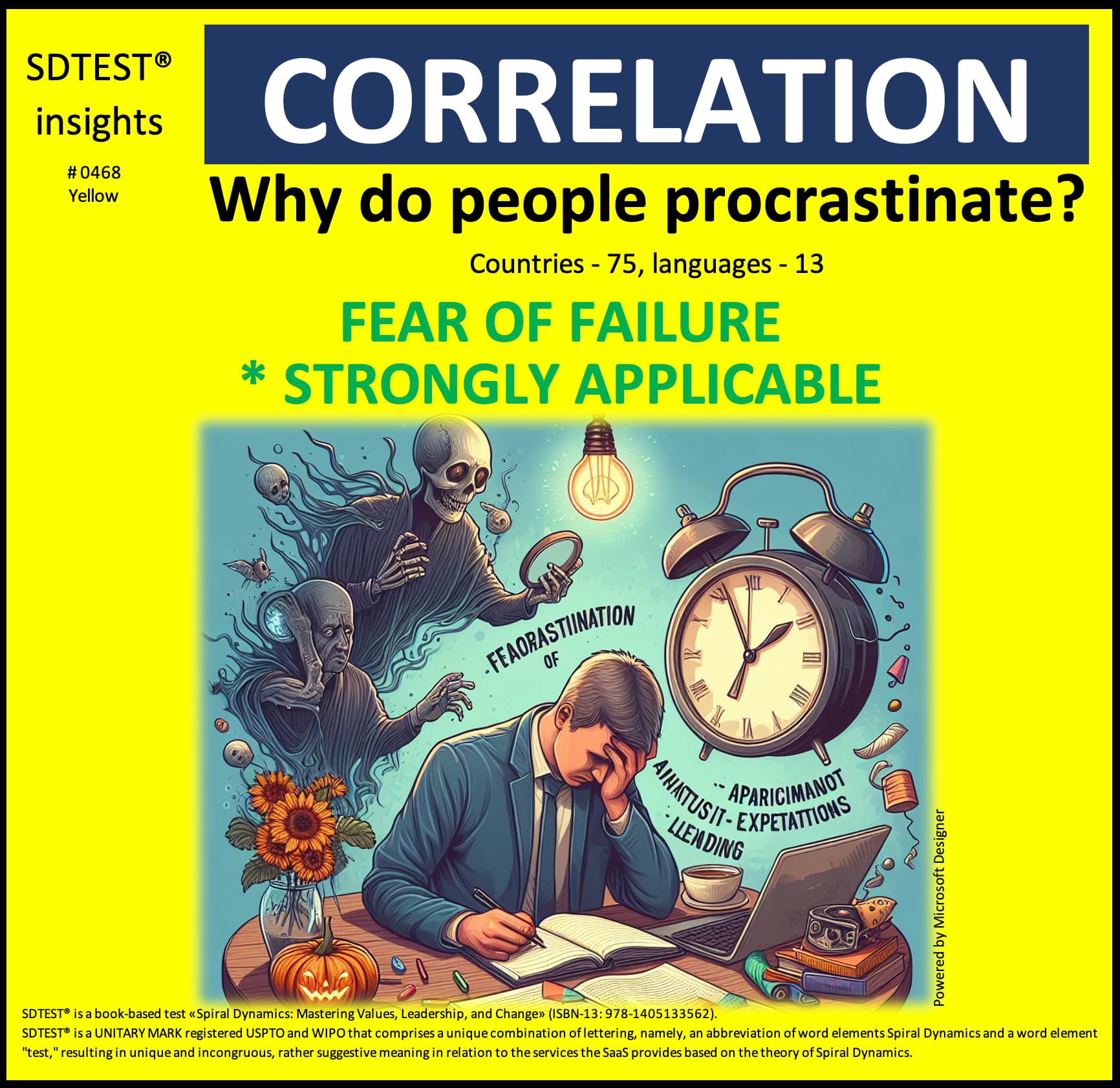SDTEST® has 38 different VUCA polls that calculate the 13,643 correlation values between stages of development according to the theory of Spiral Dynamics and answer options of these 38 polls.
We invite curiosity about the systemic mechanisms behind this correlation. There may be hidden variables that provide alternative explanations.
In our analysis of the poll "My Greatest Fears," we found an intriguing positive linear correlation that warrants closer examination:
0.0749 (Pearson) between the Deaths and the Purple stage.
The critical value of the correlation coefficient for a non-normal distribution, by Spearman, is r = 0.0013. Nevertheless, this positive linear correlation of 0.0749 meets the reliability criteria but does not necessarily imply causation.

This positive correlation of 0.0749 between Deaths as a greatest fear and the Purple stage offers intriguing insights when viewed through the lens of the Purple value system:
Organizational Perspective
Organizations operating within the Purple mindset might interpret this correlation as:
- Validation of their ancestral wisdom that recognizes death as a powerful spiritual transition requiring proper rituals.
- Confirmation that their community-protective beliefs about warding off death through collective ceremonies have merit.
- Evidence supporting their belief that organizational prosperity depends on honoring traditions that protect against death and misfortune.
These organizations might respond by:
- Strengthening ritual practices designed to protect members from death and ensure group survival.
- Implementing more ceremonial gatherings to reinforce tribal bonds that shield against mortality fears.
- Promoting leaders who can interpret spiritual signs and protect the collective from death omens.
Team Perspective
Teams operating from a Purple mindset might approach this correlation by:
- Viewing it as an affirmation of their need for protective team rituals and customs.
- Interpreting it as support for their belief that team safety comes from honoring ancestral ways.
- Seeing it as validation for prioritizing group harmony to avoid angering spirits that might bring death.
These teams might respond by:
- Establishing more protective rituals before dangerous or important team activities.
- Encouraging team members to participate in ceremonies that strengthen spiritual protection.
- Celebrating instances of successful protection from harm as proof of their spiritual connection.
Individual Perspective
Individuals aligned with the Purple value system might interpret this correlation as:
- Personal validation of their intuitive fear of death and the unknown spiritual realm.
- Evidence supporting their belief that adherence to tribal customs provides protection.
- Confirmation of the value they place on belonging to a protective kinship group.
These individuals might respond by:
- Actively seeking reassurance through participation in tribal rituals and ceremonies.
- Viewing their adherence to traditions as essential protection against death and misfortune.
- Using talismans and symbolic objects to maintain a connection with protective ancestors.
This correlation, viewed through the Purple lens, suggests that those operating at the Purple level may have a heightened awareness of death as a spiritual transition requiring proper community response. It implies that the Purple value system's focus on tradition, ceremony, and mystical protection aligns with a profound concern about maintaining spiritual harmony to prevent death and misfortune.
The reasons why Death might be seen as the greatest fear in the Purple stage could include:
- Spiritual Disruption: Death represents not just a physical ending but spiritual disruption requiring proper ceremonial management.
- Ancestral Connection: Fear of improper death rituals might anger ancestors who protect the living.
- Community Survival: Death threatens the survival knowledge and continuity of the tribal group.
- Supernatural Consequences: Death may result from breaking taboos or failing to observe proper rituals.
- Mystical Understanding: Death is viewed through a magical-mythical lens where proper ceremonies can potentially avert it.
This correlation prompts us to consider how different value systems influence perceptions of mortality. It raises questions about the potential benefits of Purple approaches to death, particularly in contexts where community support and ritual can provide comfort and meaning.
Ultimately, this correlation highlights the complex interplay between cultural values, spiritual beliefs, and human psychology. Death in Purple-dominant environments is not just a biological event but a spiritual transition requiring proper community response to maintain cosmic harmony.
In our analysis of the poll "Ageism in Career," we found an intriguing positive linear correlation that warrants closer examination:
0.1205 (Pearson) between the Organization does not benefit from having a working group to keep the conversation on ageism and the Red stage.
The critical value of the correlation coefficient for a normal distribution, by William Sealy Gosset (Student), is r = 0.0771. Nevertheless, this positive linear correlation of 0.1205 meets the reliability criteria but does not necessarily imply causation.

This positive correlation of 0.1205 between "Organization does not benefit from having a working group to keep the conversation on ageism" and the Red stage offers intriguing insights when viewed through the lens of the Red value system:
Organizational Perspective
Organizations operating within the Red mindset might interpret this correlation as:
- Validation of their power-driven approach that values strength and immediate results over social concerns.
- Confirmation that their competitive, survival-of-the-fittest culture naturally selects for the most capable, regardless of age.
- Evidence supporting their belief that specialized working groups focused on social issues like ageism create unnecessary obstacles to dominance and achievement.
These organizations might respond by:
- Dismissing ageism conversations as distractions from the core mission of conquest and victory.
- Implementing systems that reward raw power and immediate results regardless of age or experience.
- Promoting leaders who display strength and dominance rather than those advocating for inclusive policies.
Team Perspective:
Teams operating from a Red mindset might approach this correlation by:
- Viewing it as an affirmation of their aggressive, performance-driven team dynamic.
- Interpreting it as support for their belief that discussing ageism weakens team competitiveness.
- Seeing it as validation for prioritizing immediate power plays over long-term social considerations.
These teams might respond by:
- Celebrating the strongest performers regardless of age while ignoring age-related concerns.
- Encouraging team members to assert their dominance rather than discuss perceived inequalities.
- Rejecting structured conversations about ageism as signs of weakness that undermine competitive advantage.
Individual Perspective
Individuals aligned with the Red value system might interpret this correlation as:
- Personal validation of their impulse-driven approach that seeks immediate gratification and power.
- Evidence supporting their belief that discussing social issues like ageism is for the weak.
- Confirmation of the value they place on individual strength and dominance over collective sensitivities.
These individuals might respond by:
- Actively opposing efforts to establish working groups on ageism as threats to their personal power.
- Viewing their resistance to such discussions as a demonstration of strength and independence.
- Using confrontational tactics to shut down conversations about ageism they perceive as limiting their freedom.
This correlation, viewed through the Red lens, suggests that those operating at the Red level may be resistant to structured conversations about social issues like ageism. It implies that the Red value system's focus on power, impulsiveness, and immediate gratification aligns with a rejection of organizational efforts that do not directly enhance individual dominance or control.
The reasons why organizations might not benefit from having ageism working groups in the Red stage could include:
- Power Disruption: Such groups threaten established power dynamics by questioning age-based hierarchies.
- Combat Mentality: The Red stage values conflict and conquest over dialogue and inclusion.
- Immediate Results: The Red focus on immediate gratification rejects long-term cultural change initiatives.
- Individual Dominance: Working groups emphasize collective solutions rather than individual power.
- Strength Prioritization: Red values view discussions about discrimination as signs of weakness rather than strength.
This correlation prompts us to consider how different value systems influence perceptions of organizational initiatives. It raises questions about the potential clash between Red approaches to power and modern organizational efforts toward inclusion and equity.
Ultimately, this correlation highlights the complex interplay between developmental values, organizational priorities, and social issues. What might be seen as essential diversity work in other value systems appears as unnecessary or counterproductive through the Red lens of power and dominance.
In our analysis of the poll "I live thinking about my past, present or future," we found an intriguing negative linear correlation that warrants closer examination:
-0.2577 (Pearson) between the Past and the Blue stage (Germany, four languages).
The critical value of the correlation coefficient for a normal distribution, by William Sealy Gosset (Student), is r = 0.2499. Nevertheless, this negative linear correlation of -0.2577 meets the reliability criteria but does not necessarily imply causation.

This negative correlation of -0.2577 between "Past" thinking and the Blue stage in Germany offers intriguing insights when viewed through the lens of the Blue value system:
Organizational Perspective
Organizations operating within the Blue mindset might interpret this correlation as:
- Validation of their order-focused approach that emphasizes current rules and future responsibilities over dwelling on history.
- Confirmation that their structured, duty-oriented culture naturally promotes forward-looking discipline and adherence to established protocols.
- Evidence supporting their belief that organizational efficiency comes from present adherence to proper procedures rather than historical reflection.
These organizations might respond by:
- Implementing more rigorous procedural frameworks that focus members on present duties and future goals.
- Creating clearer hierarchical structures that emphasize current roles and responsibilities.
- Promoting leaders who demonstrate strict adherence to established rules and traditions.
Team Perspective
Teams operating from a Blue mindset might approach this correlation by:
- Viewing it as an affirmation of their duty-focused, present-oriented team dynamic.
- Interpreting it as support for their belief that team effectiveness comes from disciplined execution of current protocols.
- Seeing it as validation for prioritizing proper procedure and order over historical contemplation.
These teams might respond by:
- Establishing more rigid procedural guidelines to ensure consistent performance.
- Encouraging team members to focus on their prescribed roles rather than past experiences.
- Reinforcing the importance of loyal adherence to the established chain of command.
Individual Perspective
Individuals aligned with the Blue value system might interpret this correlation as:
- Personal validation of their duty-driven approach that focuses on current responsibilities.
- Evidence supporting their belief that moral integrity comes from present adherence to right conduct.
- Confirmation of the value they place on fulfilling one's proper role in the established order.
These individuals might respond by:
- Actively focusing on perfect execution of their current duties and responsibilities.
- Viewing their commitment to present rules and proper conduct as morally superior.
- Using structured daily routines to maintain order and predictability in their lives.
This correlation, viewed through the Blue lens, suggests that those operating at the Blue level in modern Germany may be less focused on past reflection and more oriented toward present order and future duties. It implies that the Blue value system's emphasis on structure, discipline, and proper conduct aligns with a mindset that prioritizes current adherence to established norms over historical contemplation.
The reasons why people might live without focusing on their past in the Blue stage in modern Germany could include:
- Procedural Focus: The German Blue mindset emphasizes current protocols and procedures over historical reflection.
- Duty Orientation: Present responsibilities and future obligations take precedence over past experiences.
- Orderly Society: Modern Germany's well-structured social systems provide clear current frameworks that demand present attention.
- Moral Certainty: The Blue value system's clear moral codes offer present guidelines that reduce the need for historical introspection.
- Hierarchical Stability: Well-defined social and organizational hierarchies provide clear present roles that focus attention on current duties.
Review of Living Conditions in Modern Germany
Modern Germany offers a high standard of living with excellent infrastructure, a strong economy, and a focus on sustainability. However, challenges such as a housing crisis, rising living costs, and stricter immigration policies are affecting residents and immigrants alike. The Blue value system’s emphasis on tradition and duty aligns with Germany’s cultural and social structures, where maintaining order and discipline is crucial. Despite these challenges, Germany remains a desirable destination for many due to its quality of life and social benefits.
In 2025, significant changes include increased housing benefits, a higher minimum wage, and new rules for migrant workers. However, rising costs and political challenges are also impacting living conditions. The Blue value system’s focus on current duties and responsibilities reflects Germany’s strong work ethic and emphasis on social responsibility, which are integral to navigating these challenges.
This correlation prompts us to consider how different value systems influence temporal orientation. It raises questions about the potential benefits of Blue approaches to time perspective, particularly in contexts where order, stability, and clear rules provide security and direction.
Ultimately, this correlation highlights the complex interplay between cultural values, psychological orientation, and social structures in modern Germany. The Blue mindset's focus on order, duty, and proper conduct may naturally direct attention away from past reflection and toward present responsibilities within the highly structured German society.
-0.1012 (Pearson) between the Employees were sent on unpaid vacations and the Orange stage.
The critical value of the correlation coefficient for a normal distribution, by William Sealy Gosset (Student), is r = 0.0521. Nevertheless, this negative linear correlation of -0.1012 meets the reliability criteria but does not necessarily imply causation.

This negative correlation of -0.1012 between "Employees were sent on unpaid vacations" and the Orange stage offers intriguing insights when viewed through the lens of the Orange value system:
Organizational Perspective
Organizations operating within the Orange mindset might interpret this correlation as:
- Validation of their results-oriented approach that recognizes human capital as a strategic asset rather than a dispensable resource.
- Confirmation that their competitive, achievement-driven culture requires maintaining engaged talent to maximize productivity and innovation.
- Evidence supporting their belief that unpaid vacations represent an inefficient, short-sighted approach to resource management.
These organizations might respond by:
- Implementing more sophisticated human capital strategies that optimize workforce productivity without losing talent.
- Creating performance-based compensation systems that align individual success with organizational objectives.
- Promoting data-driven workforce planning that identifies more rational alternatives to unpaid leave.
Team Perspective
Teams operating from an Orange mindset might approach this correlation by:
- Viewing it as an affirmation of their strategic, outcome-focused team dynamic.
- Interpreting it as support for their belief that maintaining intellectual capital is essential for competitive advantage.
- Seeing it as validation for prioritizing team performance optimization over short-term cost-cutting.
These teams might respond by:
- Developing more efficient work processes that eliminate waste rather than reducing workforce availability.
- Encouraging team members to identify innovative solutions to resource constraints.
- Using metrics and analytics to demonstrate the productivity costs of unpaid vacation policies.
Individual Perspective
Individuals aligned with the Orange value system might interpret this correlation as:
- Personal validation of their achievement-oriented approach that values strategic career management.
- Evidence supporting their belief that professional advancement requires continuous engagement and contribution.
- Confirmation of the value they place on merit-based systems that reward performance rather than imposing across-the-board measures.
These individuals might respond by:
- Actively seeking to quantify and communicate their value contribution to the organization.
- Viewing unpaid vacations as a sign of organizational inefficiency or poor strategic planning.
- Using performance metrics to negotiate continued employment during challenging periods.
This correlation, viewed through the Orange lens, suggests that those operating at the Orange level may be less likely to implement unpaid vacations as a personnel strategy. It implies that the Orange value system's focus on achievement, strategic thinking, and competitive advantage aligns with a preference for more sophisticated approaches to human capital management.
The reasons why companies might not send employees on unpaid vacations in the Orange stage could include:
- Strategic Asset Management: Human capital is viewed as a competitive advantage requiring investment rather than a cost to be minimized.
- Performance Optimization: Unpaid vacations disrupt productivity and momentum in achieving strategic objectives.
- Talent Retention: Top performers may seek opportunities with competitors if subjected to unpaid leave.
- Innovation Requirements: Continuous innovation demands consistent engagement from knowledge workers.
- Data-Driven Decision Making: Cost-benefit analyses likely demonstrate that the long-term costs of unpaid vacations (lost productivity, retraining, recruitment) outweigh short-term savings.
This correlation prompts us to consider how different value systems influence human resource strategies. It raises questions about the potential benefits of Orange approaches to workforce management, particularly in contexts where intellectual capital and innovation drive competitive advantage.
Ultimately, this correlation highlights the complex interplay between organizational values, strategic priorities, and personnel management. What might be seen as a necessary cost-cutting measure in other value systems appears as counterproductive through the Orange lens of strategic optimization and competitive advantage.
In our analysis of the poll "Gender difference in building self-confidence" (by IFD Allensbach), we found an intriguing negative linear correlation that warrants closer examination:
-0.1091 (Pearson) between the Own attractiveness and the Green stage.
The critical value of the correlation coefficient for a normal distribution, by William Sealy Gosset (Student), is r = 0.1044. Nevertheless, this negative linear correlation of -0.1091 meets the reliability criteria but does not necessarily imply causation.

This negative correlation of -0.1091 between "Own attractiveness" and the Green stage offers intriguing insights when viewed through the lens of the Green value system:
Organizational Perspective
Organizations operating within the Green mindset might interpret this correlation as:
- Validation of their inclusive approach that recognizes diverse forms of contribution beyond superficial appearance.
- Confirmation that their community-oriented culture values authentic self-expression and inner qualities over external attractiveness.
- Evidence supporting their belief that truly equitable workplaces must move beyond appearance-based judgments.
These organizations might respond by:
- Implementing more holistic performance evaluation systems that recognize emotional intelligence and collaborative skills.
- Creating workplace cultures that explicitly value diverse body types, presentations, and expressions.
- Promoting leaders who demonstrate empathy, facilitation skills, and collaborative decision-making rather than conventional attractiveness.
Team Perspective
Teams operating from a Green mindset might approach this correlation by:
- Viewing it as an affirmation of their egalitarian, consensus-based team dynamic.
- Interpreting it as support for their belief that psychological safety and authentic expression matter more than appearance.
- Seeing it as validation for prioritizing inclusive team practices over superficial judgments.
These teams might respond by:
- Facilitating more open discussions about how appearance-based biases affect team dynamics.
- Encouraging team members to develop confidence through contribution to collective goals rather than personal appearance.
- Celebrating instances of vulnerability and authentic self-expression as strengthening team cohesion.
Individual Perspective
Individuals aligned with the Green value system might interpret this correlation as:
- Personal validation of their inclusive worldview that values inner qualities over external appearance.
- Evidence supporting their belief that true self-confidence stems from authentic community contribution.
- Confirmation of the value they place on creating spaces where all people feel valued regardless of appearance.
These individuals might respond by:
- Actively working to recognize and address their own appearance-based biases.
- Viewing confidence as emerging from meaningful connection and contribution rather than physical attractiveness.
- Using their own experiences to foster more inclusive conversations about diverse sources of self-worth.
This correlation, viewed through the Green lens, suggests that those operating at the Green level may place less emphasis on physical attractiveness as a source of self-confidence. It implies that the Green value system's focus on community, inclusion, and authentic expression aligns with a more holistic understanding of personal worth beyond appearance.
The reasons why own attractiveness might not be important in building self-confidence in the Green stage at companies like Google could include:
- Diverse Value Recognition: Green organizations recognize and celebrate multiple forms of contribution beyond appearance.
- Community Connection: Self-worth in Green environments comes primarily from meaningful belonging and contribution.
- Authentic Expression: Green values prioritize genuine self-expression over conformity to conventional attractiveness standards.
- Social Equity Focus: Appearance-based confidence is seen as perpetuating systemic inequities in professional advancement.
- Holistic Well-being: Mental, emotional, and spiritual fulfillment are valued over physical appearance as sources of confidence.
This correlation prompts us to consider how different value systems influence perceptions of self-worth. It raises questions about the potential benefits of Green approaches to confidence-building, particularly in knowledge-based organizations like Google where intellectual contribution and collaborative innovation drive success.
Ultimately, this correlation highlights the complex interplay between cultural values, workplace norms, and psychological development. What might be seen as a primary source of confidence in other value systems appears less significant through the Green lens of inclusion, community, and authentic expression.
In our analysis of the poll "Why do people procrastinate?" we found an intriguing positive linear correlation that warrants closer examination:
0.1183 (Pearson) between the Fear of Failure: Apprehension or anxiety about failing or not meeting expectations, leading to avoidance of tasks / Strongly Applicable and the Yellow stage.
The critical value of the correlation coefficient for a normal distribution, by William Sealy Gosset (Student), is r = 0.0667. Nevertheless, this positive linear correlation of 0.1183 meets the reliability criteria but does not necessarily imply causation.

This positive correlation of 0.1183 between Fear of Failure as a reason for procrastination and the Yellow stage offers fascinating insights when viewed through the lens of the Yellow value system:
Organizational Perspective
Organizations operating within the Yellow mindset might interpret this correlation as:
- Recognition that even in systems-oriented, integrative environments, deeper psychological barriers persist.
- Evidence that their complex, multifaceted approach to work creates unique performance anxieties.
- Validation that higher-order thinking doesn't eliminate fundamental human concerns about inadequacy.
These organizations might respond by:
- Creating safe-to-fail environments that normalize experimentation as part of the learning process.
- Implementing reflection practices that help individuals examine their fear patterns from multiple perspectives.
- Developing holistic performance metrics that value process and growth alongside outcomes.
Team Perspective
Teams operating from a Yellow mindset might approach this correlation by:
- Viewing it as confirmation of the need to address both systemic and psychological dimensions of team dynamics.
- Interpreting it as highlighting the paradox between Yellow's theoretical embrace of failure and the emotional resistance to it.
- Seeing it as validation for creating more nuanced understanding of how fear operates across different levels of consciousness.
These teams might respond by:
- Facilitating deep dialogue sessions that explore both personal and collective shadows around failure.
- Creating team rituals that celebrate learning from mistakes as essential evolutionary processes.
- Developing contextual approaches to deadlines that accommodate different working styles and rhythms.
Individual Perspective
Individuals aligned with the Yellow value system might interpret this correlation as:
- Personal validation of the complexity they experience between intellectual understanding and emotional integration.
- Evidence supporting their intuition that higher developmental stages surface more subtle forms of resistance.
- Confirmation that their procrastination may stem from heightened awareness of interconnected consequences.
These individuals might respond by:
- Engaging in contemplative practices that help integrate intellectual understanding with emotional patterns.
- Viewing their procrastination as data about systemic tensions rather than personal shortcomings.
- Using meta-cognitive strategies to observe their fear patterns from multiple perspectives.
This correlation, viewed through the Yellow lens, suggests that those operating at the Yellow level may experience a unique form of fear of failure. It implies that the Yellow value system's heightened awareness, complexity thinking, and systems perspective may actually intensify perceived risks.
The reasons why Fear of Failure might be particularly prevalent as a cause for procrastination in the Yellow stage could include:
- Heightened Awareness: Yellow's ability to see multiple perspectives simultaneously creates awareness of more potential failure modes and consequences.
- Integration Challenges: The gap between Yellow's intellectual understanding and emotional integration creates tension between knowing failure is valuable and fearing it nonetheless.
- Systems Thinking: Understanding the ripple effects of actions across complex systems can amplify perceived stakes of failure.
- Perfectionism Evolution: Yellow-level perfectionism may shift from external validation to living up to one's own multidimensional standards.
- Paradox Navigation: The Yellow stage requires holding paradoxes, which can create decision paralysis when trying to honor multiple valid perspectives.
This correlation prompts us to consider how different value systems transform rather than eliminate fundamental human fears. It raises questions about how development might not reduce fear but rather change its nature and expression.
Ultimately, this correlation highlights the complex relationship between developmental consciousness and psychological barriers. In Yellow-dominant environments, fear of failure might manifest not as concern about external judgment but as anxiety about not fully embodying one's integrative potential.
In our analysis of the poll "Biggest problems facing my country," we found an intriguing positive linear correlation that warrants closer examination:
0.1638 (Pearson) between the Climate change and the Turquoise stage.
The critical value of the correlation coefficient for a normal distribution, by William Sealy Gosset (Student), is r = 0.0464. Nevertheless, this positive linear correlation of 0.1638 meets the reliability criteria but does not necessarily imply causation.

This positive correlation of 0.1638 between Climate Change as the biggest problem facing a country and the Turquoise stage offers profound insights when viewed through the lens of the Turquoise value system:
Organizational Perspective
Organizations operating within the Turquoise mindset might interpret this correlation as:
- Validation of their holistic worldview that recognizes the interconnectedness between human activities and planetary systems.
- Confirmation that their integrative approach to business recognizes climate change not as an isolated issue but as symptomatic of deeper systemic imbalances.
- Evidence supporting their belief that organizational purpose must extend beyond profit to address planetary wellbeing.
These organizations might respond by:
- Transforming their business models to regenerate rather than merely sustain natural systems.
- Implementing decision-making frameworks that consider impacts across multiple time horizons and ecological systems.
- Developing collaborative networks that transcend traditional industry boundaries to address climate change holistically.
Team Perspective
Teams operating from a Turquoise mindset might approach this correlation by:
- Viewing it as affirmation of their integrative understanding that connects team purpose with planetary health.
- Interpreting it as supporting their intuitive sense that climate action is inseparable from their collective work regardless of industry.
- Seeing it as validation for prioritizing climate consciousness in all aspects of team functioning and decision-making.
These teams might respond by:
- Creating fluid, adaptive work processes that mirror natural systems in their resilience and diversity.
- Fostering deep listening practices that attune to both human and more-than-human stakeholders affected by their work.
- Developing team rituals that consistently reconnect members to the living systems their work impacts.
Individual Perspective
Individuals aligned with the Turquoise value system might interpret this correlation as:
- Personal validation of their embodied understanding that human and planetary wellbeing are one integrated system.
- Evidence supporting their intuitive prioritization of climate action as central to their life's work and purpose.
- Confirmation of the values they express through lifestyle choices that reduce ecological impact.
These individuals might respond by:
- Actively integrating climate consciousness into all domains of their lives beyond conventional environmental behaviors.
- Viewing their relationship with climate change through a spiritual lens that honors the sacredness of Earth's systems.
- Using contemplative practices to process climate grief and transform it into meaningful action.
This correlation, viewed through the Turquoise lens, suggests that those operating at the Turquoise level perceive climate change not merely as an environmental issue but as a fundamental planetary crisis that reflects humanity's developmental challenges. It implies that the Turquoise value system's holistic perspective, intergenerational thinking, and spiritual connection to living systems naturally elevate climate change as a priority concern.
The reasons why Climate Change might be seen as the biggest problem facing a country in the Turquoise stage could include:
- Systems Consciousness: Turquoise thinking perceives climate change as a manifestation of systemic imbalance that affects all living systems simultaneously.
- Temporal Expansion: The Turquoise stage's expanded time horizon recognizes climate impacts across generations, elevating its importance beyond immediate concerns.
- Planetary Identity: Identification with Earth as a living system creates a felt sense of connection where planetary distress is experienced as personal distress.
- Evolutionary Perspective: Climate change represents an evolutionary challenge requiring humanity to develop new levels of collective consciousness and collaboration.
- Spiritual Integration: The Turquoise spiritual orientation recognizes climate change as both a physical and metaphysical crisis requiring inner and outer transformation.
This correlation prompts us to consider how different value systems influence perceptions of societal priorities. It raises questions about how developmental consciousness shapes our capacity to recognize, prioritize, and address complex global challenges that span multiple systems and timeframes.
Ultimately, this correlation highlights the relationship between developmental consciousness and perception of existential threats. In Turquoise-resonant environments, climate change might be understood not only as an environmental crisis but as an evolutionary driver pushing humanity toward more integrated ways of being.
What insights do you gain from today's correlation? How might we study this relationship more carefully before deducing causation?
We welcome respectful and wise perspectives! Stay tuned every week as we share more results and insights.
After login or registration, free access to the poll results in the FAQ section.
2025.04.13
FearpersonqualitiesprojectorganizationalstructureRACIresponsibilitymatrixCritical ChainProject Managementfocus factorJiraempathyleadersbossGermanyChinaPolicyUkraineRussiawarvolatilityuncertaintycomplexityambiguityVUCArelocatejobproblemcountryreasongive upobjectivekeyresultmathematicalpsychologyMBTIHR metricsstandardDEIcorrelationriskscoringmodelGame TheoryPrisoner's Dilemma
Waleri Kosenko
Önümiň eýesi SaaS SDTEST®
Waleriý 1993-nji ýylda sosial pedagog-psiholog hökmünde saýlandy we şondan soň bilimini taslamany dolandyrmakda ulandy.
Waleri 2013-nji ýylda magistr derejesini we taslama we programma menejeri derejesini aldy. Magistr programmasynyň dowamynda Taslamanyň mol kartasy (GPM Doýçe Gesellschaft für Projektmanagement e. V.) we Spiral Dynamics bilen tanyşdy.
Waleriý V.U.C.A.-nyň näbelliligini öwrenmegiň awtory. Psihologiýada Spiral Dynamics we matematiki statistika we 38 halkara pikir soralyşygy ulanmak düşünjesi.








